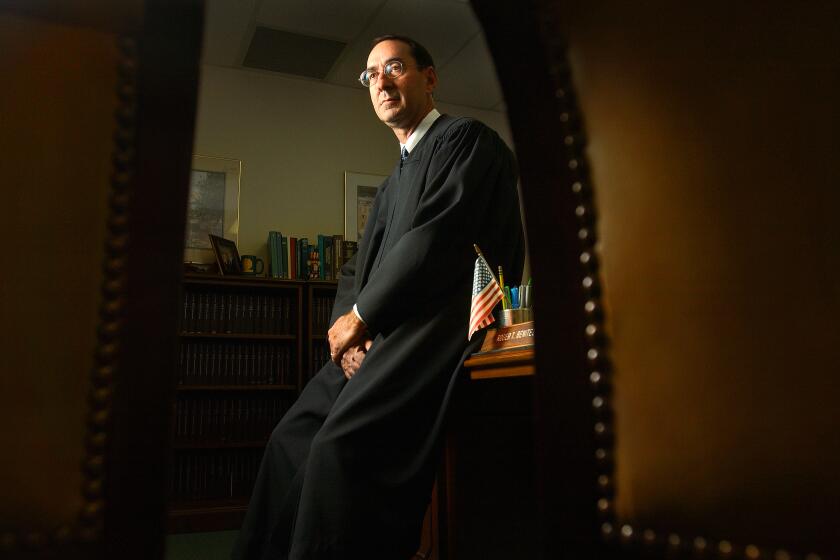NEXT L.A.: A look at issues, people and ideas helping to shape the emerging metropolis. : Chat Room : Focusing on Solutions, Not Divisions
Cal State Fullerton political scientist Raphael J. Sonenshein came to Los Angeles from northern New Jersey in 1974, having dropped out of a doctoral program at Yale University. He worked for former Mayor Tom Bradley, former councilman David Cunningham and Rep. Maxine Waters (D-Los Angeles) during her first campaign for an Assembly seat in 1976.
After several years in Los Angeles politics, he says he discovered that he “had something to say” and returned to Yale, where he wrote his PhD dissertation on the multiracial political coalition that elected Bradley. He is now a visiting scholar at USC’s Center for Multiethnic and Transnational Studies. In 1993, he published his study, “Politics in Black and White: Race and Power in Los Angeles.”
Sonenshein was interviewed by staff writer Edward J. Boyer.
*
Question: Racial and ethnic fissures in Los Angeles appear to be growing ever wider. Do you see any indications that the future holds opportunities for greater multiethnic cooperation?
Answer: I call it Back to the Future--discovering the future to some extent by what has worked in the past. I’m one of the few people still holding out for this [scenario]: citywide coalitions, joining some minorities, some whites around some kind of a common agenda. As hard as it is for people to accept, it is impossible to build a winning multiracial coalition which is all nonwhite. Numbers alone don’t allow it for one thing. Two-thirds of the registered voters in Los Angeles are white, even though they are only one-third of the population. I still believe the way to turn around this city through coalitions is to cross racial lines, cross class lines and build a coalition around what ought to be done, and what people need in their communities. That takes smart politics . . . [not] just figuring out a way to keep everybody at the table without them getting too angry. Smart politics is how to make the table bigger so that it becomes a majority.
Q: Is the table getting bigger?
A: I’ve been concerned lately about people being brought together on the basis of color. When you hold a meeting in Los Angeles now, you include an African American, a Latino and an Asian American, and then you feel that you’ve put something important together. Color may contribute to what underlies a successful coalition, but there has to be an agreement on two things: what you believe in and what your interests are. And those don’t always follow color lines. The worrisome thing I’m finding is that when people talk about building multiracial coalitions, what they’re really talking about is who should be in the coalition--not what the coalition should be doing. That’s a dead end because if you spend too much time thinking about who’s going to be sitting at the table, you suddenly discover the table is not going anywhere.
Q: But you do see people who are expanding the table, however modestly?
A: A lot of the people I work with in South-Central were trying to block the proliferation of liquor stores. They ended up getting some support from [suburban] slow-growth advocates, who said they were trying to do similar things in their communities. These people could not be from two more different universes. But what they had in common was a determination to play a role in how their neighborhoods look.
Q: And Westside environmentalists supported South-Central Los Angeles residents who fought a massive trash incinerator.
A: Absolutely. And it was an important lesson because South-Central people don’t understand the Westside, and the Westside doesn’t understand South-Central. People believe what their friends tell them or what the TV tells them.
Q: In the South-Central fight against liquor stores, Karen Bass, who heads the coalition, also enlisted the aid of Korean Americans.
A: What Karen does that is so good is that she is resolute at saying: “The problem is not that these stores are owned by Korean Americans. The problem is that these are liquor stores that are not run in the interest of the community, and I’d feel the same way if the store owner was black.” That might appear to be an obvious thing to say, but not enough people do that. You’ll never hear Karen do Korean-bashing. She has built support even among conservatives on the City Council for limiting liquor stores because she has not fallen into the race-baiting approach to this, which is so easy to get into. That means that Karen won’t get the kind of cheers at a meeting that someone would get who says, “Let’s go get the Koreans.” Karen gets things done.
Q: What other examples do you see that sustain your faith in the future of coalitions?
A: There some wonderful groups on the Eastside, such as the United Neighborhoods Organization, that once focused, for example, on getting auto insurance rates down. Justice for Janitors got a huge amount of support on the Westside even though the strike took place on the Westside in Century City. What all these people have in common is that they lead with the issue--not with the ethnicity. These groups are ethnically based but not ethnically defined. You don’t hold meetings where you exclude people on ethnic grounds. Anybody who is going to help with the problem is invited to be there. This is an old-fashioned model. The reason it doesn’t get used more is that we’ve moved into a period where people want to go more into what is called “identity politics.” The problem with identity politics is that we get into a lot of cultural arguments: I need to understand your culture, and you need to understand my culture. And if you make a single mistake in talking about my culture, we’re finished.
Q: The coalitions we’ve talked about could be described as progressive. But conservative whites--evangelical Christians, for example--have made common cause in black and Latino communities around issues such as opposition to abortion and prayer in schools.
A: Conservatives are getting smarter. They are doing a lot to figure out how to make their message one whose appeal will extend beyond whites. The progressive side no longer has the luxury of unlimited time. It’s now a competitive scene. In this competitive environment, progressives need to get better quickly. It’s dangerous when you start losing people who say, “I agree with you. In fact I’d even be better off if the progressive side won. But I don’t feel very liked.” You could have two competing multiethnic coalitions: one conservative and one more progressive.
Q: Is your vision then one that goes beyond race and ethnicity?
A: But including it. I really strongly disagree with the idea of a colorblind society. I believe in a society in which color and race are part of the debate, but you don’t become so consumed by the search for what one’s own identity is that you can no longer even focus on the problems that are right in front of you: schools, jobs, economic development. I don’t want to go back to the days when people had to pretend that race didn’t matter, that ethnicity didn’t matter, that national origin didn’t matter. But I also don’t want to move into another reality where the conversation is totally dominated by those divisions.
More to Read
Start your day right
Sign up for Essential California for news, features and recommendations from the L.A. Times and beyond in your inbox six days a week.
You may occasionally receive promotional content from the Los Angeles Times.






